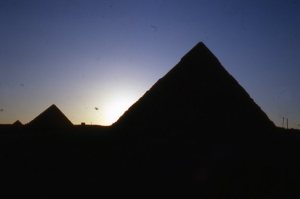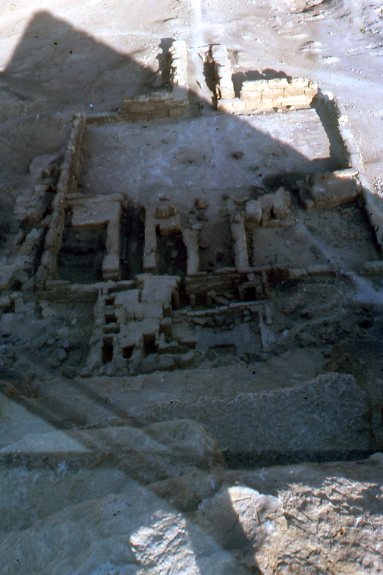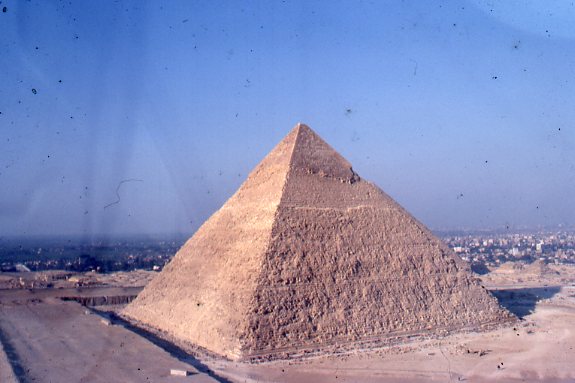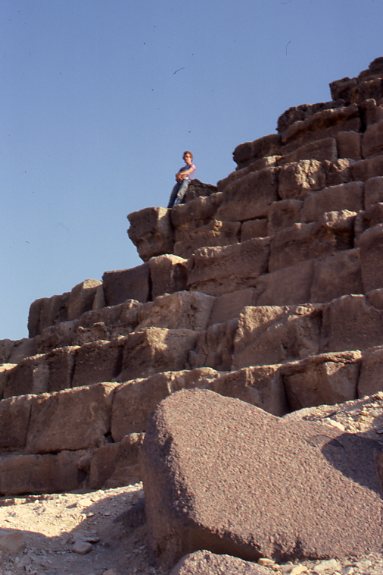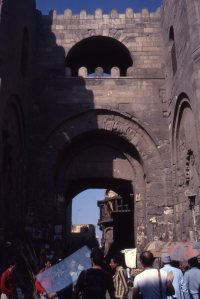There is no reason to repeat the endless speculations about the pyramids of Giza that have circulated since the first visitors from Greece recorded their impressions 2000 years ago. The gigantic stone structures were built, and they exist still. These are the only two irrefutable facts.
White stone originally encased the pyramids and they shined like beacons in the desert. The Arabs tried to pull them apart after their conquest of Egypt in the 7th century AD, but luckily for the rest of us they were not able to accomplish the task. Nonetheless many of the older mosques in Cairo were constructed with pyramid stones. What a great quarry! they must have thought.
The Arabs were the first people, however, to force their way into the Khufu Pyramid and find “The King’s Chamber.” Nothing lay within except a damaged, empty sarcophagus. No hieroglyphs on the walls, no offerings, no body.
In the nineteenth century the British discovered above the central chamber a series of empty spaces ingeniously placed at different levels to relieve the huge stresses exerted on the room by the great weight of the structure. Here someone noticed a cartouche with the name of Khufu. Today a lively debate exists as to its authenticity. Many archeologists believe the image is a fake, drawn by its discover to prove his point that Khufu built the pyramid and had been buried there. This would not the first time that a “scientist” has planted evidence to support a pet theory.
1) The Khufu, or Great Pyramid
On the opposite side of the silliness spectrum lies the so-called “pyramid inch.” This arbitrary unit, invented by yet another Brit, can be used to extrapolate all kinds of prophecies when different passageways and so forth are measured and scrutinized utilizing these “inches.” I like numerology, but not of this wild nature. Still, it’s a fun game anyone can play, so long as they visit Giza with a proper tape measure.
2) Giza at sunset
Far better sport used to be available. In decades past, visitors routinely climbed the Great Pyramid and enjoyed salubrious views of Cairo, the Nile, and the desert from its summit. This practice is now highly discouraged, I understand, but in 1975 when I first visited Egypt, the procedure was simple. You waited until the guards looked distracted, then bolted up the first hundred feet or so. At that point you could ignore their whistles and shouts. As the guards were not paid enough to chase you up the stonework, if you made it far enough you were good to continue the rest of the way.
Given that the angle of the pyramid conforms to its equilateral design, you climbed on a 52 degree slope. Each stone was chest-high, with about a two-foot flat surface on top. A fall would risk serious injury or worse, as you were likely to bounce all the way down to the desert floor below. Hard to say. I never knew of anyone actually making the tumble.
I did hear a couple of good stories. One tale held that within the indentation on the southeast side, about two-thirds of the way up the pyramid, a man used to sit every day with a hookah and offer puffs of hash to passing climbers. Another rumor maintained that when King Faisal of Saudi Arabia visited Giza, he watched a local guy climb up and down the pyramid in six minutes, and was so impressed he gave the man a bag of cash on the spot.
I enjoy these stories; true or not, they sound well in my ears.
While climbing the Great Pyramid I noticed graffiti dating back centuries. Greek, Latin, Cyrillic, Arabic; most of the major Western scripts were ground into the stones. Soldiers from the time of the French and British occupations listed their regiments and battalions or whatever, along with the date of their visits. Humans, of course, have always hoped to immortalize their anonymous selves by carving their names into monumental structures. I resisted the temptation.
The summit was a small plateau, perhaps the size of a tennis court. A crude wooden post of uncertain vintage marks the center. The original capstone of the Great Pyramid is gone, sacrificed to quarrying Arabs. I remained there for a couple of hours, admiring the views and finally sunset behind the Citadel in Cairo.
_____
In 1980 I returned to Giza, along with my wife at the time and my parents. I wanted to show Mom and Dad the art of pyramid climbing, but the Khufu monument was well scrutinized by the local authorities. So I wandered over to its smaller cousin, the Pyramid of Menkaure. We saw no officious-looking guards nearby. I said to my parents, “Watch this!” and up we scrambled. MC Couture accompanied me on the ascent and as she held our camera and the following photos of the climb are hers:
3) The Menkaure pyramid’s shadow
4) The view from the summit. The building top center contains the famous funerary boat found near the Great Pyramid. I am barely visible on the edge of the angled corner, making my way up
5) The Khafre Pyramid – the streaks in the photo are from an Egyptian airport x-ray machine, not alien energy weapons. No photo-shopping here. You can see the remains of the original casing material near the summit of the pyramid
6) Near the bottom of the Menkaure pyramid
7) As an aside, the Bab Zuweila Gate in Cairo, originally constructed from pharaonic stones, most likely from the pyramids. Just goes to show, everybody has climbed them at one time or another


